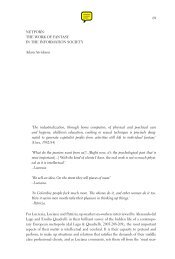Nakamura, Digitizing Race, Introduction, chapter 5, Epilogue
Nakamura, Digitizing Race, Introduction, chapter 5, Epilogue
Nakamura, Digitizing Race, Introduction, chapter 5, Epilogue
You also want an ePaper? Increase the reach of your titles
YUMPU automatically turns print PDFs into web optimized ePapers that Google loves.
The Social Optics of <strong>Race</strong> 127<br />
a vat of liquid and tended like machinery: just like ranks of expensive mainframe<br />
computers in “server farms” that need to be kept at precise temperatures<br />
and levels of humidity so that they can continue to process information<br />
in parallel with each other, the Precogs are networked to each other<br />
and to the imaging screens that let the detectives see their visions. This<br />
imagery of factory farming is intensified in later footage of the prison where<br />
the unconscious Anderton is interred. The convicts occupy tiny cells among<br />
vast ranks of other tiny cells. The imagery of the factory prison echoes that<br />
of the awe-inspiringly vast ranks of metal pods displayed in The Matrix trilogy,<br />
each containing a single sleeping wired-up human adult-fetus bathed in<br />
a cell of liquid. In Minority Report these futuristic prison cells contain criminals,<br />
another growing population who, as Castells notes, are a major component<br />
of the Fourth World, who are networked to a computer that keeps<br />
them unconscious and unable to move, and are literally buried in the earth.<br />
Anderton’s loss in status, identity, and safety, in short, the loss of his<br />
privilege, the privilege to see everyone and everything from the perspective<br />
of the state and as a representative of its dataveillant mode of vision, reflects<br />
the ways in which the Fourth World is radically marginalized. As Williams<br />
writes, Agatha the Precog exemplifies this plight: hers is the most “traumatic<br />
subjectivity” in the film. From a “refuse class of society,” she has been<br />
displaced “from even consumerist subjectivity and its mediated, mitigated<br />
relation to citizenship.” The child of a single mother, a drug addict whose<br />
use of an experimental substance has resulted in the mutations that enable<br />
her child to see future crimes, Agatha is both divine and oppressed. Played<br />
by the ethereal Samantha Morton, Agatha is a child trapped in a woman’s<br />
body. She has never worn clothes and can barely walk. She also has no data<br />
profile; when read, her retina tells no story of retail habits, crime, job status,<br />
or geographic location. Having lived in a vat all her life, she has had no<br />
opportunity to acquire one. She is figured very much as an object of interactivity,<br />
while the policemen who “read” her are its de facto subjects. Anderton’s<br />
framing and expulsion from the police force are meant to remind us<br />
that it is really the dataveillant state that owns them both.<br />
Minority Report literalizes Lisa Lowe’s formulation of Asians as both capital<br />
and labor, 58 for while Cruise capitalizes on the hapless Mr. Yakamoto’s<br />
disembodied eyes, the custom-built computer imaging hardware that enables<br />
him to manipulate the Precognitives’ films of murders-to-be is produced for<br />
him by “Rufus T. Reilly,” the South Asian American cyberparlor operator.<br />
The dark, curly-haired, garrulous Reilly runs a shady virtual reality service that<br />
allows users to experience their unsavory fantasies, such as sex with multiple





